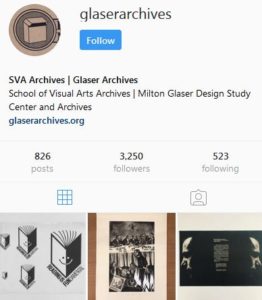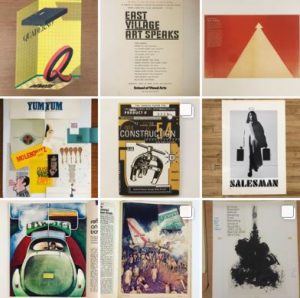
On September 19, 2018, I visited the School of Visual Arts archive collection to meet their head archivist, Beth Kleber, and assistant archivist, Lawrence Griffin. During my observation, Kleber and I discussed the SVA archives, their work in it, and their background overall. During our conversation, they discussed the specific needs of working in an academic archive and art material, the skills they developed in this process, and their perceptions of how the field has changed in the past years.
The SVA Archives was started by Kleber when a designer and professor decided to donate his collection to the donated to the school. The Archives has grown since its establishment in 2006 and now as a repository of historical records, work by professors, work by students and alumni, and internal documentation. Material, which was stored in grey boxes and flat files in two rooms, date back to when the school was founded. Since the university is “like a family owned business,” much of the material remains within the university and has support from the President’s Office.
The collection can be divided into two, with one side being the Milton Glaser Design Study Center and Archives (art and design material), and the other being the SVA Archives (history of the school). Kleber and Griffin work with both sides of the collection. The archives is considered a nonprofit (due to donations), but has close ties with the library of the university (which is not a nonprofit). As a result, the Archives collection is physically housed in the back of the floor of the Library. Most of the material being hosted in a temperature controlled room. The two sides of the collection are housed together, which is possible because so many designers have relationships with the school and have designed for the school in some way. Numerous designers, as well as photographers and illustrators, are active professors at the school.
The observation day was not during a period in which archives were being actively used, but Kleber explained that the archive is usually used by visiting classes, researchers, and designers. It is open to the SVA community as well as the public. She mentioned visitors coming from other states, and even other countries, and noted that some boxes near a flat table were used for such visits. Because of the material type, most objects are stored flat. Items such as film can be scanned or put on a portable lightbox for viewing. There was also an overhead camera for digitization. Kleber noted that, in some cases, she sends material out to be scanned if the intention was for reprinting. Some people visit because of the Instagram that the archivist manage, illustrating that the archives had a virtual presence and existed well beyond the two storage rooms.

Griffin described some of the skills he used during the past year and half in which he has been at SVA. Among them were digital skills such as Photoshop and coding. He manages the web archiving through a subscription program, Archive-It. He also has machines for older technology, such as reel-to-reel and cassettes, in his office. He and Kleber also perform a lot of administrative work, such as answering email inquiries, scheduling appointments, meeting with academic departments, and filing paperwork.
Both Griffin and Kleber have knowledge of archival practices, but also use their knowledge of design and design history in their work. Kleber, who has an impressive memory, was able to connect names to posters, faces, and events over the course of years. She also pulls posters from the Library bulletin in order to preserve them, because not all academic departments send all of their material to the Archives. However, for those who do, Kleber and Griffin were able to build a collection of posters, booklets, publications, flyers, and other types of digital and physical material of various mediums. As mentioned during class discussions, the archivist can shape the narrative of a collection with their decision to keep, or not keep, material. Kleber’s specific history with the archive, being there since the first object entered the collection, her knowledge informs how materials relate, even if pieces arrive at the archive years after. At the same time, her history with the archive means she often sees an overabundance of material from academic departments year after year. In some cases, some materials may be difficult to keep.
Among their collection were profiles on professors and exhibitions related to their Photography Department. They had copies of an interview with photographer Duane Michals. They also had postcards of images made by professors, among them Penelope Umbrico. For designers, the design side of their archive is named after the famous Milton Glaser, most well-known for his “I Love New York” design. He works as a professor in the MFA Design program and donated much of his work to the collection. The Archives also has work by another professor, Keith Godard, who among other things, created the hat mosaics in the 23rd Street Station on the MTA R line.

In discussing the changes in the field, Kleber and Griffin noted the some technological and conceptual differences in the graduate programs they attended, compared to programs today. Kleber attended Queens College, but found working as a librarian more valuable in teaching her about the field than school. She noted that Queens College did not have an archive focus when she was attending her courses, but that the New York Public Library had a program that paid for her studies while she worked in various branches throughout the city. She eventually became an archivist due to Glaser’s donation to the school, and built the archive ever since.
Griffin also attended Queens College, and also found the experience of working to be more valuable. Unlike Kleber, who mainly worked in city libraries and archives, Griffin also worked for government organizations and historical societies. He noted that the experiences in different organizations vary dramatically, mostly on an administrative level.
The visit to the SVA Archives provided valuable information about academic archives, especially those in an art or design focused school. A lot of the archive is dependent on the work of the archivist, and the relationships the archivists can make with professors and departments. It is also valuable to know the subject matter, such as the name of designers and time periods, in order to perform research and connect information. While skills such as material preservation and digitization are important, what seems clear is that the field is shifting differently. The academic experience of the SVA archivists is very different from archive programs today, and the technology that one needs to know seems more specific on the institution rather than the field. Beyond technical standards and social concepts, archivists will need to know social media and communication skills in order to gain the cooperation and enthusiasm of the greater community.
Alvina Lai